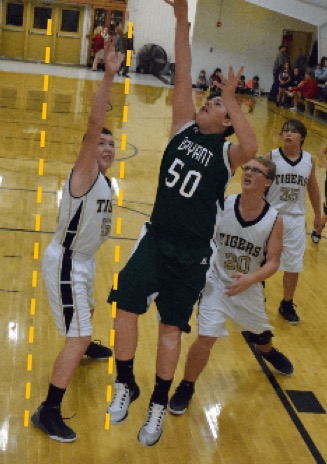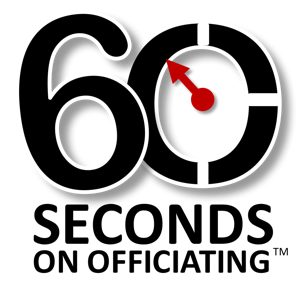
This Plane is Broken
When airplanes become broken it can cause a real problem, especially while in flight. But in the scholastic basketball game a broken plane results in either a violation or foul based on the situation.
Are you aware of the key plane factors as it relates to keeping separation between the offensive player and the defender?
 Here’s a quick 60 Second look at these important concepts of verticality:
Here’s a quick 60 Second look at these important concepts of verticality:
- The vertical plane is an imaginary line that starts on the floor and extends to the ceiling.
- These planes can associated with a player (defender or screener) and every line on the basketball court (end-line, side-line, free-throw line, etc).
- For a defender, they are considered to be in this plane when they are in a legal guarding position with their hands extended straight above their head. Defenders are legally permitted to rise or jump in this vertical plane – but must stay in that plane.
- Screeners also have this imaginary vertical plane around them — but must keep their stance approximately shoulder width apart, or less.
- For a side-line or end-line and during a throw-in, the plane starts on the inner edge closest to the inbounds side of the court and extends to the ceiling.
- Opponents must not “break” the vertical plane — of the player or painted line. If they do — it will be penalized in one way or another.
That’s right. Players have vertical planes and so do the painted lines of the court.
So why are these planes so important especially when broken?
When it comes to the Principle of Verticality, the defender should not be penalized if they started in a legal guarding position and the offensive player initiated contact — by breaking into their plane. This puts the defender at a disadvantage and a player (or team) control foul may be ruled.
The opposite occurs when the defender moves outside their vertical plane and contacts their opponent — by breaking into their vertical plane. This puts the offensive player (ball handler / screener) at a disadvantage and a common foul on the defender may be ruled.
During a throw-in, opponents of the team inbounding the ball must not break the vertical plane of the end-line or side-line with any part of their body until the ball is released. This falls under the delay of game scenarios. The penalty for “breaking this plane” is a warning for the first offense and a technical foul for any subsequent violations, which includes any delay of game warnings by that team — of any kind.
These two types of planes, people and lines, create a buffer between the offense and defense maintaining fairness and balance in the game.
As an official follow these simple tips to get the best view of the plane to judge if a violation or foul occurred.
- During a throw-in, position yourself so your head and eyes are looking down the line and in the SAME PLANE as the line. This gives you a great view of a defender reaching through this plane — or if the thrower violates by stepping across the line.
- Bounce the ball whenever you are permitted during a throw-in. This give you an opportunity to step away from the thrower and get a wider field of view. Sometimes if you are too close (like on an end-line throw-in) after handing the ball to the inbounder, you might miss these plane infractions.
- When officiating an offensive / defensive match-up, position yourself in a way you can see the DEFENSE and their vertical plane. You’ve probably heard many times — “referee the defense” and this is the exact reason. Moving to improve your position and taking a primary look at the defender will give you the highest chance of making the proper ruling when it comes to the burden of contact.
There are other “planes” that carry restrictions when a player can break them. These include the free-throw line, the 3-pt Arc and the Center Restraining Circle just to name a few.
Remember, these imaginary planes are real and should be enforced when broken. Strive to obtain a good angle to view these planes and you will always be on the right side of the ruling.
Rule References
4-45 , 7-6-4

if the person inbounding the ball holds the ball over the inbound line can the defender take the ball from the inbounders hand?
Section 2 Art. 10 : NOTE: “The thrower may penetrate the plane provided he/she does not touch the inbounds area or a player inbounds before the ball is released on the throw-in pass. The opponent in this situation may legally touch or grasp the ball”
Section 2 Throw-In-Provisions Art.10 Note:……
During an alternating possession throw-in, the thrower (A-1) breaks the plane of the boundary line with the ball. B-1 grasps the ball and neither player can get the ball from one another. What’s the ruling?
Ruling: The official should rule a HELD BALL ball and give the ball back to team A for a new alternating possession throw-in, since the arrow is still pointing toward team A.
NFHS Reference: 6-4-4, 4-42-5a
Can a Player in-bounding a ball have partial foot touching the end line before releasing or releasing the ball ?
I believe that is allowable since the thrower is still out of bounds. Even bouncing the ball is ok as long as he is bouncing on the line or out of bounds. If they bounce the ball on the court I know it can be taken but is there a violation for doing that?